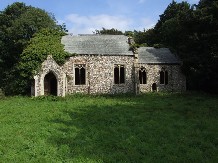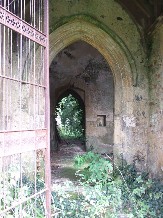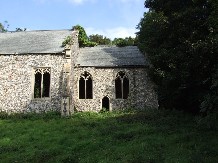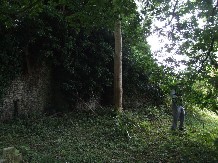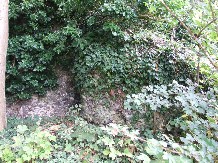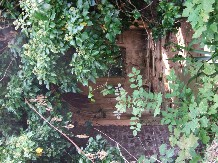| |
|
St Peter,
North Burlingham
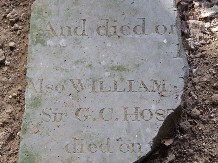 |
|
It
was Historic Churches bike ride day 2007. We had
been to Hemblington, explaining our plans for the
day to the nice lady on welcoming duty, and to a
gentleman cyclist who had just checked in.
"Don't forget that there is a ruined church
at North Burlingham", he said. We hadn't
forgotten, and already had plans to track it
down, but we wondered if access to it was
possible. "Certainly", said the nice
man. "I own it. It's in my back garden. I
give you permission." If only it
was always that easy. Thanking him profusely, we
headed on back down to the A47. North Burlingham
is bypassed these days, but not by much, and the
thunder of traffic was very noticeable after the
peace of Witton and Hemblington. It is not a huge
parish, but was obviously busy enough to maintain
two churches well in the second half of the 19th
century, when both underwent major restorations. St Andrew, a couple
of hundred yards to the west, is a big, late
medieval building with a huge tower, but St Peter
was more typical of the area, a smaller, older
church with a round tower.
|
It was the
tower that led to the demise of the building. One night
in 1906, it collapsed into the nave. At first, the gap
was merely boarded up, but, not surprisingly, this was
found to be unsatisfactory, and in 1936 the remains of
the congregation finally decamped up the road to St Andrew. The building has
been left to decay since then, pretty much, quietly
returning back to nature. Ashes to ashes, dust to dust.
It is hard to see beyond its restoration, but this must
have been a little Norman church, perhaps with a 13th
century chancel.
| We
stepped into what must have become a completely
Victorianised building in the 1870s. Now, little
remains. Victorian tiling forms an aisle up the
middle to the off-centre chancel arch. The roof
timbers are mostly still in place, although
completely unsafe. There are broken ledger
stones, and you can see into the vault beneath
the chancel floor. There was
an elegant, quiet dignity about the building on
this beautiful sunny day. The elder and ivy
filtered the light as if they were stained glass
windows, and although the building is now nothing
but a faltering shell, it was quite possible to
repopulate it in the mind's eye with 19th century
furnishings and people. There are quaint niches
either side of the east window in a Decorated
style, and I wondered if this was a suggestion
that St Peter had been quite High Church in its
19th century heyday, perhaps as an alternative to
Lower worship at St Andrew.
|
|
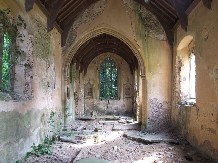 |
There was plenty of time for the furnishings
and treasures to be removed, of course, and they have
been mostly reinstated up the road at St Andrew. There
you will find the pretty rood screen, now filling the
mouth of the tower arch. Also there are the memorials,
including two medieval brasses.
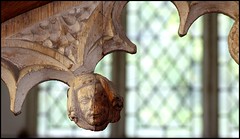 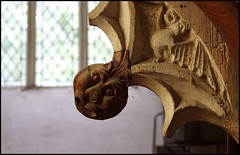
The
medieval benches went across the A47 to Blofield, and
other furnishings went to Earlham and Lingwood. The bells
are in the keeping of the Norfolk Museum Service, along
with so many extraordinary treasures in the great storage
warehouse at Gressenhall.
Norfolk
has many ruined churches. I have already visited fifty or
so of them, and there are plenty more to come. But there
was something particularly atmospheric about the interior
and setting of this particular ruin. It would be
impossible to find such a place sinister or eerie, for it
is organic and harmonious. As if to accentuate this
oneness with nature, a dead barn owl lay on the nave
floor. It seemed not inappropriate. It was, as Tom
observed, a good ruin.
| We
wandered through and around to the north side of
the church. Here, hauntingly, there are surviving
gravestones, dotted among the trees. The latest
appeared to date from the 1920s or so, a cross
for James William Oliver, who died aged 17
months. If he had lived, he would have been 85
this year. I wondered if anyone ever came here to
remember him. There was something particularly
poignant about these forgotten headstones, so
close to the busy road but utterly unknown. We came
round the west end, to find the remains of the
round tower virtually indistinguishable from the
uneven flinty earth about them. Light shone
through from the nave and out of the former tower
arch, now a pergola for hanging ivy. As I
watched, a blackbird alighted on the ledge, the
light spangling his feathers. He opened his mouth
and gave a throaty warble for a moment - then saw
us, and was gone.
|
|
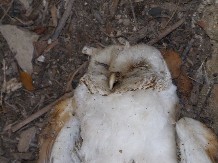 |
|
|

